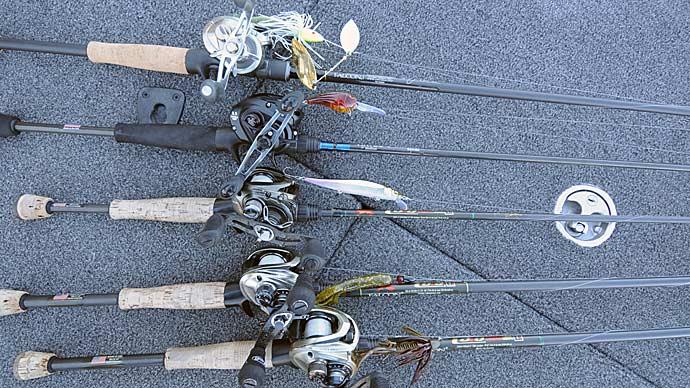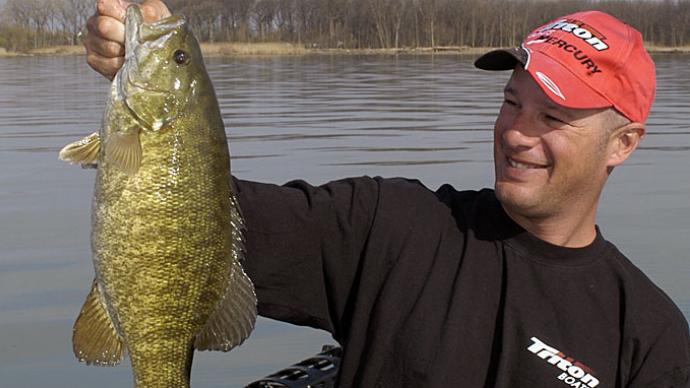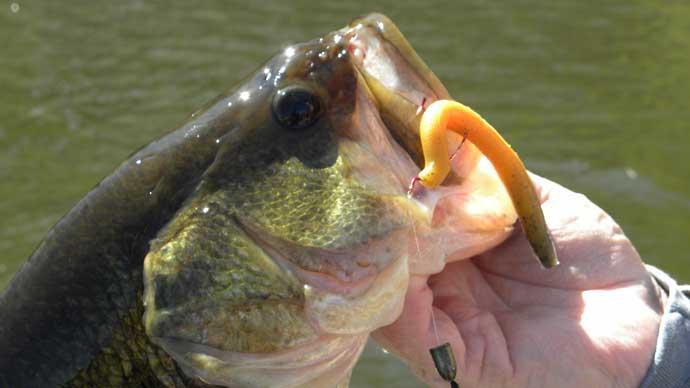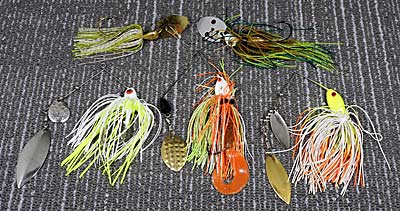
After a long, cold Winter, your first couple of times back on the water can be challenging, especially if you face harsh weather conditions. Yes, it is easier to find and catch bass on bright sunny days, but what are your go-to tactics if you're faced with a few days of sunny skies only to be followed by a few days of cold and rain? Let's break down early-season cold water search baits to have in your arsenal and give you a few tips for finding bass early in the season and getting them to bite.
The first few baits I want to discuss are the heavy metal of early season bass.
Spinnerbaits
Regarding early-season bass fishing, the first bait I grab is a spinnerbait. Much of this lies in the fact that when fishing a spinnerbait, you have choices in how to fish a single bait. I can fish it shallow, or I can fish it deep. I can make it have more sound or give it more flash. A big part of how you'll fish a spinnerbait early in the season will relate to what you think the bass are doing, then modify your spinnerbait to stay in the strike zone longer and trigger bites along the way.
There are a few things that you must figure out. My starting point is the clarity of the water that I'm fishing. Is it clean or dirty? It will determine my blade setup and the depth I need to fish my spinnerbait to get bites.
Colorado Blades
With this information, I'll set up the blade configuration of my spinner bait. If I'm fishing in dirty water conditions where the bass will have difficulty seeing my bait, I'll pick a spinnerbait with a Colorado or Indiana blade setup. The Colorado blade puts off the most sound and has more lift than other blades.
Suppose you're fishing in dirty water conditions where you need to use sound to help the bass find your bait; a Colorado blade will be your choice. Also, if you need to keep your bait above the cover, a Colorado blade will be what you want to arm your spinnerbait with.
Indiana Blades
Indiana Blades are shaped more like a teardrop. They don't put off as much sound or have as much lift as a Colorado blade. They fall in between a Colorado and a willow blade. I will pick this blade when fishing in clearer water conditions or when I need to get my bait down deeper in the water column.
Willow Blades
When it comes to willow blades, these blades put off more flash than sound and have the least lift. When fishing in clear, deeper water conditions, I'll do most of my fishing with a spinnerbait equipped with willow blades. I use the flash of the blades more than sound to attract bites. I'll often be fishing these over deeper weed flats, trying to draw fish out to show themselves early in the season and work from there.
Another key when fishing a spinnerbait is your skirt color and trailer choice. Once again, watercolor and the forage I'm trying to imitate will come into play. I'll use my skirt choice to send that message. If I'm fishing in clearwater conditions, this will be a straightforward choice, but when faced with dirty water conditions, I will make sure my skirts and trailer will have an accent color or sound to help the bass find my bait. Regarding trailers, I'll pick this according to what I need to do with my spinnerbait or the depth at which I'm fishing the bait.
If fishing shallow, I'll choose a grub or double tail as my attractor. I'll lean towards a 3" to 4" swimbait as my trailer when fishing in dirty water. The simple reason behind this choice is that the sound and action of the swimbait will add to the bait. A swimbait puts off more vibration than a twin-tail trailer, making it easier for a bass to find my bait.
When assembling your spinnerbait combination, pay special attention to your blades, skirt, and trailer, as it will substantially affect how your spinnerbait fishes and gets bites. It's no longer just days that you pick a white/chartreuse skirted Colorado bladed spinnerbait and start casting. Consider what you're targeting and adjust your spinnerbait makeup to help your bait better fit your fishing conditions.
Vibrating Jigs
When the Chatterbait came onto the bass scene, I first saw this bait at ICAST a few months before its introduction. As I walked the aisle, I saw a demonstration in a small tank in front of the Rad Lures booth. Standing there looking at the demo, I walked away thinking it would be just a flash in the pan here today and gone tomorrow. The new season started, and the Chatterbait dominated the first few tournaments, carrying Brian Thrift and David Fritts to wins. The Chatterbait is still a force to reckon with early in the season and all year.
Over the years, many other companies have put their twist into the vibrating jig mix, and now they are a go-to in many circles. Blade shapes and patterns have changed through the years, giving this bait more exploration choices. A few things have caught my eye when it comes to blades. The straight silver blade is still the most popular choice, but blades are now starting to come in many more colors and painted patterns to better imitate forage. Give some of these a try to expand your options and give the bass something they may not have seen before to help trigger more strikes.
When selecting skirts, try to match the forage that you're trying to imitate, but I also carry a few skirts that are off-the-wall colors and try to give the bass that sees a lot of vibrating jig choices something that they don't see. This change alone will get you more bites on tough days in many waters. Carry an assortment of trailers in your mix of grubs, twin tails, and swimbaits. Match your trailer to the action and look that you want. I have noticed that the more aggressive you get with your trailer, the more it will subdue the bait's action. Pay attention to how the vibrating jigs run and act with different trailers.
I have also expanded the sizes that I carry regularly. Many anglers just stock 3/8oz and 1/2oz baits. I carry 3/8oz, 1/2oz, 3/4oz, and 1oz of baits in my box. I push the envelope of where I now fish a vibrating jig in today's environment and have succeeded.
Crankbaits
Crankbaits are a top pick during the cold water period of the season. I don't depend on just one style or category regarding crankbait. I broke it down into three categories: if one doesn't work, another one or two will function as a backup and pick up the load.
Shad Rap & Flicker Shad

The first category is the Rapala Shad Rap or shad-style bait like a Berkley Flicker Shad. These are light baits to cast, so most of the time, I'll fish them on a spinning setup, a 7-foot medium-action rod that is equipped with a 200-size spinning reel that is spooled with either 8lb or 10lb Sunline Crank FC line. I have no problems casting the bait a distance from the boat and getting the bait into the 8ft to 10ft depth to be in the bite zone. This bait has a tight wobble and mimics a shad to a tee as it swims. I will turn towards the Shad Rap when fishing in clear water conditions, and I'll depend on the Flicker Shad when faced with fishing in dirty water conditions, as the colors I use stand out a little more. It also comes in more sizes than the Shad Rap to fill some needed gaps.
Flat Sided Crankbaits
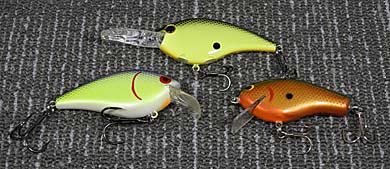
Flat-sided crankbaits have a limited following, but because they're labeled cold-water crankbaits, fishermen don't throw them throughout the year, which is a mistake. The biggest reason is that this bait can flat-out catch bass when given a chance. It has a wider wobble than many of the other crankbait you have in your box. One downside: it's a tough bait to cast into the wind, and often, in the Spring, you're fishing in windy conditions.
I stock Berkley’s Frittside and Strike King Chick Magnet flat sides in my box. The wide wobble action of these baits is the key, and you can fish them in all conditions. I have had my best results cranking this bait down to its diving depth and using a stop-and-go retrieve in short, fast bursts. You'll get many bites when you start the bait again, but here is a little thing to watch for. Make your cast, reel the bait to its diving depth, and stop it. After a few seconds, give the reel handle a few quick turns and stop again. If you see the line start to go slack, there is a good chance that a bass has grabbed your bait. I can't tell you how many times I have not felt the bite happen but started to reel again, and there is a bass on the line. If you pay closer attention, you can see your line go slack or jump and set the hook before the bass can spit the bait back out again.
Square Bills
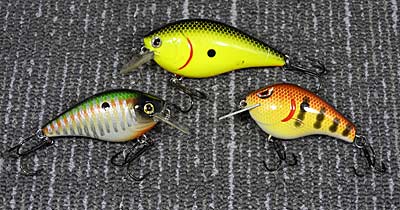
Square bills come in many shapes and forms. I stock both rattle and silent baits to cover as many bases as possible. I also stock forage color patterns and bright color patterns to match water conditions better as well. When fishing a square bill, try to get your bait to deflect off anything that you can find. The more contact your bait makes on its way back to the boat, the more bites you'll trigger. I have a few different square bill setups that I fish. If I'm fishing around cover, I'll use a Denali Lithium Pro 7-foot medium-action baitcaster that is teamed with a Denali Pro Baitcaster reel spooled with 12lb Sunline Crank FC. I want a shorter rod to better target cover on the shore, hitting my targets better with a shorter rod choice.
If fishing in open areas, I will use a Denali 7'6" Lithium Pro medium-heavy action baitcast rod. I will team this with a Denali Pro Baitcaster spooled with 10lb Sunline Crank FC. The longer rod choice is because of the greater casting distance, which leads to being able to cover more water with each cast. Also, with the longer rod, I get better control over the bass to keep them from jumping and throwing the bait on me out a distance from the boat.
Make sure all your hooks are sticky and sharp on your crankbaits. Of all the baits we discussed, crankbaits are the most accessible bait for bass to throw and get off. Make sure you check your hooks a couple of times during the day; if any are dull, take a few minutes to touch them up again. This will result in more bass over the side of your boat than lost.
These early-season cold-water search baits help you catch more bass when the bite is tough. At this time of the season, it is vital that you make the right decision along the way. As the water warms, bass will become more active, and so will the bite. Embrace the new season, and I hope you have a great year.
BassResource may receive a portion of revenues if you make a purchase using a link above.


